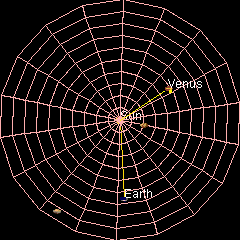

Venus has an orbit with a semi-major axis of 0.723 au (108,200,000 km; 67,200,000 mi), and an eccentricity of 0.007.[1][2] The low eccentricity and comparatively small size of its orbit give Venus the least range in distance between perihelion and aphelion of the planets: 1.46 million km. The planet orbits the Sun once every 225 days[3] and travels 4.54 au (679,000,000 km; 422,000,000 mi) in doing so,[4] giving an average orbital speed of 35 km/s (78,000 mph).
- ^ Simon, J.L.; Bretagnon, P.; Chapront, J.; Chapront-Touzé, M.; Francou, G.; Laskar, J. (February 1994). "Numerical expressions for precession formulae and mean elements for the Moon and planets". Astronomy and Astrophysics. 282 (2): 663–683. Bibcode:1994A&A...282..663S.
- ^ Jean Meeus, Astronomical Formulæ for Calculators, by Jean Meeus. (Richmond, VA: Willmann-Bell, 1988) 99. Elements by Simon Newcomb
- ^ The sidereal and anomalistic years are both 224.7008 days long. The sidereal year is the time taken to revolve around the Sun relative to a fixed reference frame. More precisely, the sidereal year is one way to express the rate of change of the mean longitude at one instant, with respect to a fixed equinox. The calculation shows how long it would take for the longitude to make one revolution at the given rate. The anomalistic year is the time span between successive closest approaches to the Sun. This may be calculated in the same manner as the sidereal year, but the mean anomaly is used.
- ^ Jean Meeus, Astronomical Algorithms (Richmond, VA: Willmann-Bell, 1998) 238. The formula by Ramanujan is accurate enough.